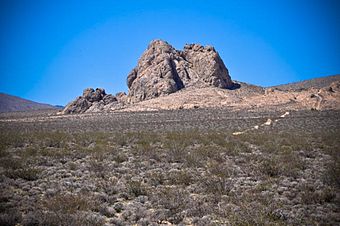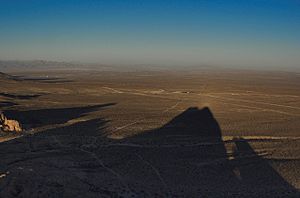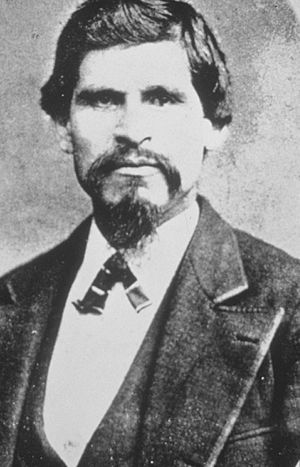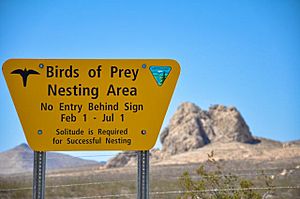Robbers Roost (Kern County, California) facts for kids
Quick facts for kids |
|
|
Robbers Roost
|
|
 |
|
| Location | Kern County, California |
|---|---|
| Area | 5 acres (2.0 ha) |
| NRHP reference No. | 75000431 |
| Added to NRHP | October 31, 1975 |
Robbers Roost is a unique rock formation located in Kern County, California. It's also known as Robber's Roost or Bandit Rock. This special spot is found in the foothills of the Scodie Mountains, which are part of the Southern Sierra Nevada mountain range. It sits in the northern part of the Mojave Desert.
From Robbers Roost, you can see far across the southern Indian Wells Valley. The closest town is Ridgecrest, California. The Los Angeles Aqueduct, a big water channel, is also very close by. The land around Robbers Roost is managed by the Bureau of Land Management. You can find Robbers Roost west of Freeman Junction, where California highways 178 and 14 meet.
Contents
A Hideout for Bandits
In the 1800s, Robbers Roost was a perfect hideout for outlaws. They used the high rocks to watch for stagecoaches traveling south toward Los Angeles. These stagecoaches often carried valuable gold and gems from local mines. The outlaws also watched for coaches heading west through Walker Pass, which is now California State Route 178.
The rough, jagged rocks of Robbers Roost made it an ideal secret spot. It was a famous hideout for one of Kern County's most well-known bandit groups. This group was led by a man named Tiburcio Vásquez.
Robbers Roost: A Historic Place
Robbers Roost was added to the National Register of Historic Places in 1975. This means it's recognized as an important historical site.
The giant rock stands about 4,000 feet high. This height gave bandits an amazing view for miles in every direction. The many cracks, caves, and rocky spots offered great protection from the harsh desert weather. They also provided excellent places to hide.
Even today, this steep and rugged lookout looks much the same as it did when Vásquez used it.
Tiburcio Vásquez and His Gang
Tiburcio Vásquez was a famous bandit in California. He was known for robbing stagecoaches and travelers. He started his life of crime around the mid-1800s. After spending time in prison, he became a free man in 1863. He then joined other bandit groups and later became the leader of his own gang around 1871.
Vásquez and his gang became very bold. They planned their robberies in the desert where stories of rich mines and wealthy travelers were common. They wanted to steal money and jewels, which were easier to carry than heavy gold.
Vásquez first appeared at Coyote Holes in 1874. This was a stagecoach station where the Walker Pass road met the freight road to Los Angeles. His local camp was in the rocky peaks south of Coyote Holes station. From that time on, this jagged rock, easily seen from Highway 14, became known as Robbers Roost.
Vásquez and his gang continued their robberies until army groups tried to capture them. This made Vásquez leave the desert and go back to the Los Angeles area. He was finally caught there. His bandit days ended in 1875.
While many other bandits roamed the California desert, Vásquez and his gang were the most famous.
Visiting Robbers Roost
If you plan to visit Robbers Roost, there's an important rule to know. The area is closed from February 1st through July 1st each year. This closure helps protect birds of prey that nest there. It gives them the peace and quiet they need to raise their young.






